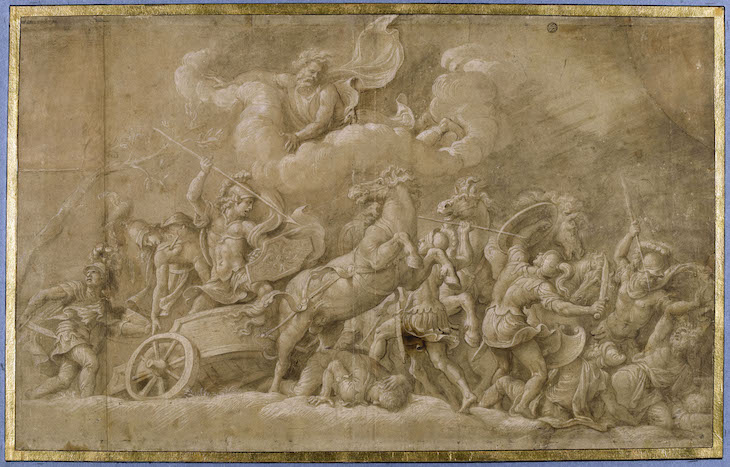He is often called Raphael’s heir, but Giulio Romano set little store by his master’s renowned virtues of sweetness and serenity. As these two major exhibitions in his adopted home of Mantua show, the painter and architect instead defined a new Mannerist style that was capricious, subversively anticlassical, and often zealously erotic. The display at the Palazzo Ducale, ‘With a new and extravagant manner’, centres on the unprecedented loan of 72 drawings from the Louvre, while the display at Palazzo Te forges connections between Romano and other erotic artists of his age. Find out more from the ‘Giulio Romano 2019’ events website.
Preview the exhibition below | View Apollo’s Art Diary here

Diomedes Fighting Ideus and Phlegeus, Giulio Romano
Romano’s flair is encapsulated in his drawings, which are among the most imitated of the 16th century. This scene depicts the combat of Diomedes from The Iliad; at the Palazzo Ducale, it will be reunited for the first time with the great fresco in the Trojan Room that depicts the same subject.

The Lovers (c. 1525), Giulio Romano. State Hermitage Museum, St Petersburg
In this painting, loaned by the Hermitage in St Petersburg for the exhibition at Palazzo Te, Romano’s besotted lovers stare into one another’s eyes as though there is nothing else in the world. Scattered across the scene around them, however, are clues to the elicit nature of their encounter: the small cat, sneaking around in the shadows; the lady in waiting at the door, come to warn that the woman’s husband is approaching; the satyr and nymph carved on the bed-frame, alluding to Zeus’s liaison with Antiope. An imbalance in the matrimonial home was a favourite subject for Romano – and stylistically, his innovation was to throw the Renaissance ideal of perfect symmetry off-kilter, as shown here by the leftwards lean of the composition, and its abrupt halt at the thrown-open door.

Detail of a fresco from the Sala di Amore at the Palazzo Te (1524–34), Giulio Romano and workshop.
As an architect, Romano’s masterpiece was the Palazzo Te, constructed between 1524–34 as a suburban pleasure palace for Federico Gonzago II. The building makes reference to the High Renaissance principles of Donato Bramante, and yet adapts them in whimsical ways: spezzato plaster on the surfaces, and rusticated columns. The Palazzo Te is also Romano’s most famous achievement as a painter, for virtually every surface is covered by frescoes. There is a room for portraits of the horses of the Gonzaga family, and, as shown here, a series of frescoes depicting the loves of the gods.

The ceiling of the Sala dei Giganti at the Palazzo Te (1524–34), Giulio Romano and workshop.
At the heart of the Palazzo Te is Romano’s crowning achievement. Every inch of the Sala dei Giganti (room of Giants) – down to the fireplace – is incorporated into this circular trompe l’oeil composition of the gods repelling the hapless Titans from heaven.











![Masterpiece [Re]discovery 2022. Photo: Ben Fisher Photography, courtesy of Masterpiece London](http://www.apollo-magazine.com/wp-content/uploads/2022/07/MPL2022_4263.jpg)
Has the Fitzwilliam lost the hang of things?